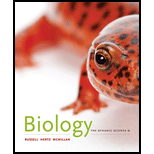
Concept explainers
Working on the Amazon River, a biologist isolated DNA from two unknown organisms, P and Q. He discovered that the adenine content of P was 15% and the cytosine content of Q was 42%. This means that:
a. the amount of guanine in P is 15%.
b. the amount of guanine and cytosine combined in P is 70%.
c. the amount of adenine in Q is 42%.
d. the amount of thymine in Q is 21%.
e. it takes more energy to unwind the DNA of P than theDNA of Q.
Introduction:
The genetic material in DNA (deoxyribonucleic acid) contains four types of nucleotides. These nucleotides consist of sugar, deoxyribose, a phosphate group, and a nitrogen base. There are four types of nitrogenous bases that are present in DNA. These are guanine, adenine, cytosine, and thymine. The guanine and adenine are purines and cytosine and thymine are pyrimidines.
Answer to Problem 1TYK
Correct answer:
The content of guanine and cytosine combined in P is 70%.
Explanation of Solution
Justification for the correct answer:
Option (b) states that the amount of guanine and cytosine combined in P is 70%. The amount of adenine content of P was 15%, which means that the amount of thymine must also be 15%. This makes up 30%, which means that the other two bases guanine and cytosine constitute 70% of the content. Hence, option (b) is correct.
Justification for the incorrect answers:
Option (a) states that the amount of guanine in P is 15%. The amount of adenine and thymine is 15% and the sum of the other two bases guanine and cytosine is 70%. The amount of guanine is equal to that of cytosine, so each base must be 35% and not 15%. So, it is an incorrect option.
Option (c) states that the amount of adenine in Q is 42%. The amount of cytosine in Q is 42% and because the amount of guanine is equal to that of cytosine, the sum of cytosine and guanine in Q must be 84%. The other two bases adenine and thymine, thus constitute 16% of the content, which means that adenine must be 8% and not 42%. So, it is an incorrect option.
Option (d) states that the amount of thymine in Q is 21%. The amount of cytosine in Q is 42% and because the amount of guanine is equal to that of cytosine, the sum of cytosine and guanine in Q must be 84%. The other two bases adenine and thymine constitute 16% of the content, which means that thymine must be 8% and not 21%. So, it is an incorrect option.
Option (e) states that it takes more energy to unwind the DNA of P than to unwind the DNA of Q. There are three hydrogen bonds between guanine and cytosine and two between adenine and thymine. It will take more energy to break three hydrogen bonds than to break two hydrogen bonds. The sum of guanine and cytosine content in P is 70% of the content and in Q is 84% of the content. Thus, it takes more energy to unwind the DNA of Q than to unwind the DNA of P. So, it is an incorrect option.
Hence, options, (a), (c), (d), and (e) are incorrect.
Thus, it can be concluded that the total content of guanine and cytosine in the organism P is 70%. This is because the amount of adenine is equal to that of thymine and the amount of adenine is equal to that of thymine in DNA. The total amount of adenine and thymine in the organism P is 30%.
Want to see more full solutions like this?
Chapter 14 Solutions
Biology: The Dynamic Science (MindTap Course List)
- What is behavioral adaptarrow_forward22. Which of the following mutant proteins is expected to have a dominant negative effect when over- expressed in normal cells? a. mutant PI3-kinase that lacks the SH2 domain but retains the kinase function b. mutant Grb2 protein that cannot bind to RTK c. mutant RTK that lacks the extracellular domain d. mutant PDK that has the PH domain but lost the kinase function e. all of the abovearrow_forwardWhat is the label ?arrow_forward
- Can you described the image? Can you explain the question as well their answer and how to get to an answer to an problem like this?arrow_forwardglg 112 mid unit assignment Identifying melting processesarrow_forwardGive only the mode of inheritance consistent with all three pedigrees and only two reasons that support this, nothing more, (it shouldn't take too long)arrow_forward
- Oarrow_forwardDescribe the principle of homeostasis.arrow_forwardExplain how the hormones of the glands listed below travel around the body to target organs and tissues : Pituitary gland Hypothalamus Thyroid Parathyroid Adrenal Pineal Pancreas(islets of langerhans) Gonads (testes and ovaries) Placentaarrow_forward
 Biology: The Dynamic Science (MindTap Course List)BiologyISBN:9781305389892Author:Peter J. Russell, Paul E. Hertz, Beverly McMillanPublisher:Cengage Learning
Biology: The Dynamic Science (MindTap Course List)BiologyISBN:9781305389892Author:Peter J. Russell, Paul E. Hertz, Beverly McMillanPublisher:Cengage Learning Human Heredity: Principles and Issues (MindTap Co...BiologyISBN:9781305251052Author:Michael CummingsPublisher:Cengage Learning
Human Heredity: Principles and Issues (MindTap Co...BiologyISBN:9781305251052Author:Michael CummingsPublisher:Cengage Learning Concepts of BiologyBiologyISBN:9781938168116Author:Samantha Fowler, Rebecca Roush, James WisePublisher:OpenStax College
Concepts of BiologyBiologyISBN:9781938168116Author:Samantha Fowler, Rebecca Roush, James WisePublisher:OpenStax College Biology Today and Tomorrow without Physiology (Mi...BiologyISBN:9781305117396Author:Cecie Starr, Christine Evers, Lisa StarrPublisher:Cengage Learning
Biology Today and Tomorrow without Physiology (Mi...BiologyISBN:9781305117396Author:Cecie Starr, Christine Evers, Lisa StarrPublisher:Cengage Learning
 Biology (MindTap Course List)BiologyISBN:9781337392938Author:Eldra Solomon, Charles Martin, Diana W. Martin, Linda R. BergPublisher:Cengage Learning
Biology (MindTap Course List)BiologyISBN:9781337392938Author:Eldra Solomon, Charles Martin, Diana W. Martin, Linda R. BergPublisher:Cengage Learning





